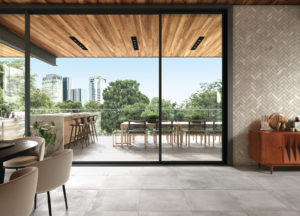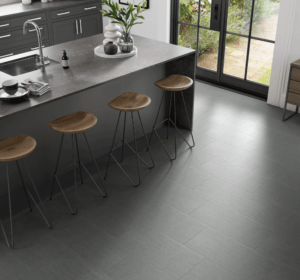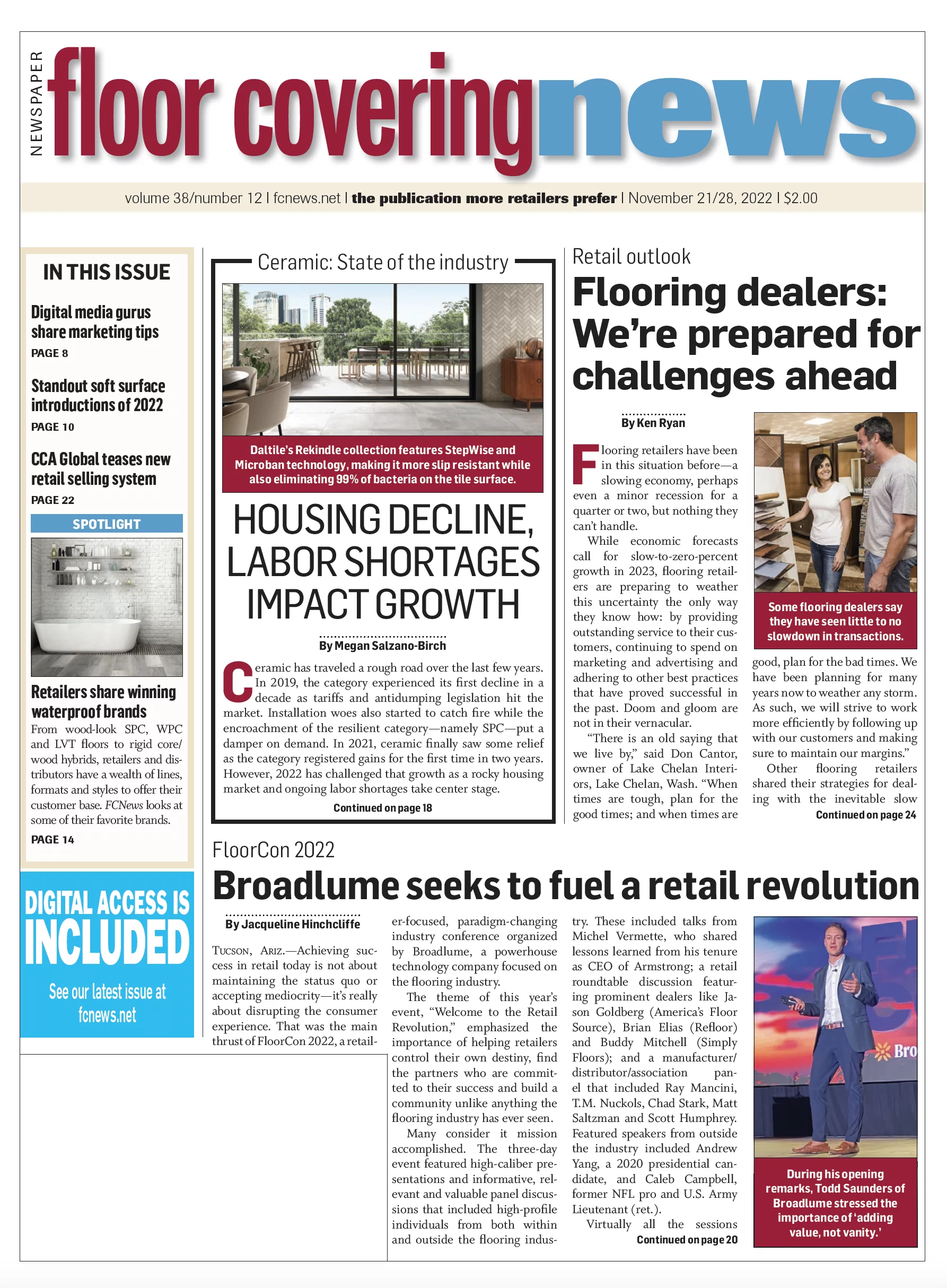
Ceramic has traveled a rough road over the last few years. In 2019, the tile flooring category experienced its first decline in a decade as tariffs and antidumping legislation hit the market. Installation woes also started to catch fire while the encroachment of the resilient category—namely SPC—put a damper on demand. In 2021, ceramic finally saw some relief as the category registered gains for the first time in two years. However, 2022 has challenged that growth as a rocky housing market and ongoing labor shortages take center stage.
While national suppliers and ceramic tile flooring importers still point to the positive effects of the pandemic—extended home stays and the new work-from-home lifestyle leading to exploding renovation rates—as a boon to the category, those effects have begun to wane.
In fact, according to the Tile Council of North America (TCNA), total U.S. ceramic tile consumption was down 2% by volume throughout the second quarter of 2022 versus the same time last year. However, there may be light at the end of the tunnel as the TCNA puts total August 2022 U.S. ceramic tile consumption at 2.11 billion square feet, up 0.7% compared to the same time last year. What’s more promising is total consumption in value, which the TCNA reported as $3.03 billion, up a whopping 17.6% versus August 2021.
Housing makes its mark
Many industry experts point to the housing market as a reliable indicator of the health of ceramic. Unfortunately, the housing market in the final months of 2022 is not projected to be advantageous for the tile category. Coming off the initial boon to business in 2021, the housing market has started to experience decline across the board.
According to the National Association of Home Builders (NAHB), elevated mortgage rates, high construction costs and weakening demand stemming from deteriorating affordability conditions continue to act as a drag on single-family housing production.
Overall housing starts decreased 4.2% to a seasonally adjusted annual rate of 1.43 million units in October, according to a report from the U.S. Department of Housing and Urban Development and the U.S. Census Bureau. Year-to-date, single-family starts are down 7.1%.
“This will be the first year since 2011 to post a calendar year decline for single-family starts,” said Robert Dietz, NAHB chief economist. “We are forecasting additional declines for single-family construction in 2023, which means economic slowing will expand from the residential construction market into the rest of the economy.”
Within the multi-family sector, another important market for ceramic, the prospects for continued high levels of development declined significantly in the third quarter, as did the prospects for continued high occupancy rates, according to results from the Multi-family Market Survey (MMS) released by the NAHB. The MMS produces two separate indices: The Multi-family Production Index (MPI) decreased 10 points to 32 compared to the previous quarter while the Multi-family Occupancy Index (MOI) fell 15 points to 45—the lowest level since the first quarter of 2010, with the exception of the onset of the pandemic in the spring of 2020.
“Multi-family developers are becoming cautious, as supply constraints have caused a large backlog of projects started but not yet completed to accumulate in the pipeline,” NAHB’s Dietz said. “An emerging additional constraint is financing for new multi-family development, which 79% of developers say is somewhat or significantly less available than it was a year ago. NAHB is now projecting a significant decline in multi-family starts in 2023.”
Inflation and the supply chain
Inflation has indeed become the buzzword of the day as pressure mounts across the board. The impacts are being felt regardless of category, industry sector or even demographic. “The distinct challenges the industry has faced and continues to face start with inflation,” said Patrick Warren, vice president of residential sales, dealer & showrooms, Dal-Tile. “Inflation has continued to be a headwind as raw material and fuel prices keep rising at unprecedented rates, which puts pressure on the whole construction cycle from manufacturing to installation. We have been and will continue to work around the clock to bring down costs and maximize productivity to minimize the burden on our customers.”
In addition, Warren noted, the supply chain continued to be a challenge both domestically and internationally between driver shortages, increasing rates and port congestion.
Paulo Pereira, senior merchant, MSI, agreed, noting major issues surrounding price hikes due to the increase in both production costs and transportation costs, as well as a slowdown in home sales due to the recent mortgage rate increases—with 30-year mortgage fixed rates now close to 7%. However, there is a bright side. “We have seen some corrections starting to happen as a result of the lower demand that is impacting the overall economy,” he noted. “Both production and transportation costs are starting to decrease, which will help tile to remain competitive compared to alternate hard surface floors and wall products.”
Rich Rose, vice president, sales support and special projects at Emser Tile, noted that the uncertain economy will likely impact the volume of projects or cause some to reconsider materials and choices to keep budgets under control. However, he added that also means considering the best possible materials for the project. “The consumers’ demands have expanded with new construction but also with home renovation and improvement projects. Regardless of budget there is still a desire for quality products that offer bold colors and patterns. Tile offers the variety of looks and styles desired along with ease of maintenance, durability and performance.”
Rocamador Rubio of Tile of Spain said these major challenges are, thankfully, all things leaders in the industry have been working on for some time. “First, finding contingency supply chain routes for raw materials that can be actioned quickly is paramount,” he told FCNews. “The industry is taking a dual-prong approach to this by not only seeking new sources for common materials but also working hard on R&D to develop new solutions. Fuel sources and energy optimization are another major issue the industry has been working hard on in Europe for decades now. With advancements like heat-siphoning, co-generation and the development of high-efficiency electric for certain parts of the firing process, the industry has a roadmap to 2050 that will reduce energy consumption, emissions and carbon footprint dramatically by that date.”
Tackling labor shortages
High demand for qualified labor is not something new for ceramic tile flooring. Perhaps more so than any other flooring category, tile flooring installation requires skilled, artisanal laborers—whose absence from the industry puts a uniquely particular strain on the category.
“The availability of qualified and trained tile installers has been a concern for a number of years,” explained Bart Bettiga, executive director, National Tile Contractors Association (NTCA). “COVID-19 temporarily slowed down construction work, but then construction picked up very quickly when quarantines were lifted. In the case of residential construction, tile installers are extremely busy. Because it takes several years to master all aspects of quality tile installation, it is perhaps more challenging for our industry—versus some other aspects of construction—to react quickly to an increasing demand for qualified labor. The challenges, though, of training are not limited to the tile industry. Most skilled trades and flooring categories are faced with the growing dilemma of finding new people to replace those who are nearing retirement.”
The labor challenge is not just limited to North American entities. “The shortage of installers is a central problem in the development of ceramic consumption in the U.S.,” said Andrea Serri of Confindustria Ceramica. “Most require the presence of the installer, whose limited numbers can slow down the evolution of the market. Training is fundamental since knowledge and good laying practices allow for high-quality results that are appreciated by the consumer. Customer references represent an extraordinary opportunity for further circulation of the material.”
MSI’s Pereira agreed, noting the pandemic’s impact on the issue. “This trend has been affecting tile sales for many years and it got aggravated during the pandemic,” he explained. “The sudden increase in demand made it difficult to find available tile installers, which contributed to the market share gains experienced by competitive products such as LVT and carpet. Recent efforts to train and graduate tile installers are now in place, but in a low-unemployment environment the younger generation has multiple job selections and tile installer is not an appealing opportunity.”
Emser’s Rose noted that tile can be an amazingly durable and beautiful product that will last for years—if it is correctly installed. “Unfortunately, untrained installers and the use of improper installation practices can be a challenge for the tile and stone business. Training and education support on proper installation practices and the use of quality materials can help ease some of the challenges on the labor side, and Emser works to support the industry by always recommending proper installation and working with setting materials partners to educate the trade.”
Dal-Tile’s Warren said the powerhouse brand also seeks to address the labor challenge. “We continue to partner with all trade associations on developing training/career programs to educate on the benefits of being an installer. Also, one of Daltile’s newest innovations, RevoTile, aims to provide a solution. RevoTile is a porcelain tile floating floor system that installs two-times faster than traditional tile. The tile product is so easy to install that it opens up the possibility of installation by any flooring installer (hardwood, LVT, laminate)—not just professional tile installers.”
Impacts of innovation

While ceramic has unique challenges it also has unique benefits that many other categories cannot claim. Touted as the “original waterproof material,” tile is one of only two truly aspirational flooring categories and perhaps the only category to claim the kind of style and design achieved today. That said, continued innovation within the category is thought by many to be the key to the category’s future success.
“Both the enhanced performance features as well as the ability to produce realistic visuals/texture are improving tile’s value proposition to U.S. consumers,” Dal-Tile’s Warren said.
Daltile has been churning out innovative product lines since its inception. One of its most recent innovations is the company’s new Rekindle collection, which is said to be two-times more slip resistant than regular tile while also eliminating 99% of bacteria on the surface, according to the company. These high-performance features are made possible through the inclusion of StepWise and Microban technologies that won’t wear off or wash away. Rekindle is a concrete-look, large-format tile available in five earthy tones.
MSI also continues to roll out enhanced product lines in an effort to illustrate the category’s prowess. “Innovation is definitely helping improve ceramic tile’s proposition, since it is expanding the product application to areas originally dominated by other hard surface products,” Pereira said. “Porcelain slabs are gaining momentum on countertop applications and porcelain pavers are becoming the landscape contractor’s preference for outdoor patio applications.”

MSI’s Calacatta Miraggio series in both gold and gray colors coordinate with its Miraggio Quartz program, offering a trend coordination that starts on the countertop and extends to the backsplash, floor/wall and outdoor paver.
“Modern ceramic tile has become the chameleon of home design because it can be manufactured to mimic a variety of different materials, making it nearly indistinguishable from the original,” Emser’s Rose explained.
Examples of this technology can be seen in Emser’s Jute, a glazed porcelain that is nearly identical to jute textile; Boxwood, a glazed ceramic plank tile that captures the beauty of natural wood; and Reform, a glazed porcelain that features layers of texture giving it a luxurious stone look.

